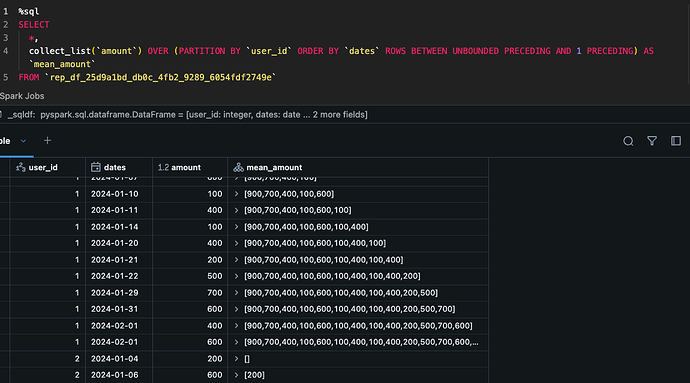( long question)
In sparklyr, the usage of mutate in a window function way generates strangely different sql.
Create dataset:
library("tidyverse")
# a user's total transaction per day is recorded. If there is no transactions by the user on a particular day,
# then there is no row.
set.seed(100)
rep_df =
tibble::tibble(
user_id = sample(1:100, 1000, replace = TRUE),
dates = seq(as_date("2024-01-01"), as_date("2024-02-01"), 1) %>%
sample(1000, replace = TRUE),
amount = sample(seq(100, 900, 100), 1000, replace = TRUE)
) %>%
summarise(amount = sum(amount), .by = c(user_id, dates))
rep_df
user_id dates amount
<int> <date> <dbl>
1 74 2024-01-23 1500
2 89 2024-01-29 100
3 78 2024-02-01 300
4 23 2024-01-07 700
5 86 2024-01-16 1100
6 70 2024-01-18 400
7 4 2024-01-08 600
8 55 2024-01-14 600
9 70 2024-01-28 900
10 98 2024-01-04 1300
Intent: Create an array of all previous transactions per row.
# standard tidyverse code
rep_df %>%
arrange(user_id, dates) %>%
group_by(user_id) %>%
mutate(prev_amounts = slider::slide(amount,
identity,
.before = Inf,
.after = -1
)
) %>%
ungroup()
provides the expected output
# A tibble: 852 × 4
user_id dates amount prev_amounts
<int> <date> <dbl> <list>
1 1 2024-01-01 400 <dbl [0]>
2 1 2024-01-02 200 <dbl [1]>
3 1 2024-01-04 800 <dbl [2]>
4 1 2024-01-05 800 <dbl [3]>
5 1 2024-01-10 900 <dbl [4]>
6 1 2024-01-12 900 <dbl [5]>
7 1 2024-01-17 500 <dbl [6]>
8 1 2024-01-26 100 <dbl [7]>
9 1 2024-01-29 300 <dbl [8]>
10 2 2024-01-01 1000 <dbl [0]>
# ℹ 842 more rows
# ℹ Use `print(n = ...)` to see more rows
Consider, rep_sdf to the spark counterpart of rep_df.
The following code creates the expected sql:
rep_sdf %>%
group_by(user_id) %>%
dbplyr::window_order(dates) %>%
dbplyr::window_frame(-Inf, -1) %>%
mutate(mean_amount = mean(amount)) %>% # note 'mean' here
dbplyr::sql_render()
sql generated:
SELECT
*,
AVG(`amount`) OVER (PARTITION BY `user_id` ORDER BY `dates` ROWS BETWEEN UNBOUNDED PRECEDING AND 1 PRECEDING) AS `mean_amount`
FROM `rep_df_25d9a1bd_db0c_4fb2_9289_6054fdf2749e`
Lets try to do what we did with tidyverse code:
rep_sdf %>%
group_by(user_id) %>%
dbplyr::window_order(dates) %>%
dbplyr::window_frame(-Inf, -1) %>%
mutate(list_amount = collect_list(amount)) %>% # note 'collect_list' instead of 'mean' here
# mutate(list_amount = sql("collect_list(amount)")) %>% # this does not work either
dbplyr::sql_render()
This generated the following sql:
SELECT *, collect_list(`amount`) AS `list_amount`
FROM `rep_df_25d9a1bd_db0c_4fb2_9289_6054fdf2749e`
Problem:
- All window information is lost!
For my surprise, changing the word 'AVG' to 'collect_list' in the valid sql (generated using 'mean') works:
sdf_sql(con, "
SELECT
*,
collect_list(`amount`) OVER (PARTITION BY `user_id` ORDER BY `dates` ROWS BETWEEN UNBOUNDED PRECEDING AND 1 PRECEDING) AS `mean_amount`
FROM `rep_df_25d9a1bd_db0c_4fb2_9289_6054fdf2749e`")
Questions:
- Is there a different canonical way to achieve this with dplyr?
- Is this a bug or shortcoming?
